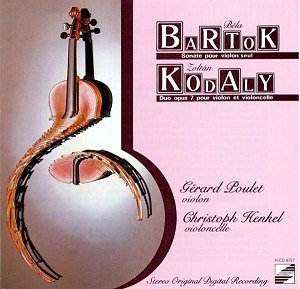 Composer: Béla Bartók
Composer: Béla Bartók
Works: Sonata for Solo Violin; Zoltán Kodály: Duo Op. 7
Performers: Gérard Poulet (violin), Christoph Henkel (cello)
Recording: Chateau de Ripaille, Thonon des Bains, Haute-Savoie, France, May 14th-17th, 1987
Label: Harmonic Records HCD8717
Béla Bartók’s Sonata for Solo Violin stands as a profound testament to the composer’s late style, reflecting a synthesis of folk elements and avant-garde techniques. Commissioned by Yehudi Menuhin in 1943, the sonata was composed in 1944, a time when Bartók’s music became increasingly introspective, possibly as a response to the tumultuous events surrounding him. This recording, featuring Gérard Poulet, is an inspired coupling with Zoltán Kodály’s Duo Op. 7, a work that showcases Kodály’s lyrical sophistication and his deep understanding of string sonority.
Poulet’s interpretation of Bartók’s sonata is striking, characterized by a gritty determination that aligns perfectly with the work’s inherent tension. The opening movement is delivered with an exquisite lyricism, particularly in the way Poulet spins the melodic line around 7:30-45, where the violin’s voice emerges as both a solo and a dialogue with the silence that surrounds it. The finale’s buzzing energy contrasts sharply with the reflective qualities of the earlier movements, and Poulet navigates this dichotomy with skillful articulation and an impressive command of his instrument. His sweet tone is particularly captivating in the third movement, “Melodia,” where the poignant expressiveness resonates deeply, allowing listeners to engage meaningfully with Bartók’s musical processes.
In tandem with Poulet, cellist Christoph Henkel brings a rich, warm timbre to Kodály’s Duo Op. 7, composed in 1914. Their performance of the opening movement features a delicate interplay that highlights the intimate rapport between the two instruments. Notably, at around 6:30, Poulet’s exquisite tonal control complements Henkel’s sonorous depth, creating a tapestry of sound that is both complex and unified. The slow movement presents a stark contrast, as the two instrumental voices traverse large, desolate pitch spaces—an effect that Kodály masterfully orchestrates. The palpable tension created in this segment speaks to the performers’ mutual understanding and interpretative depth, emphasizing the emotional landscape that Kodály intended.
The recording quality from May 1987 is exemplary, capturing the nuanced interplay between violin and cello with clarity that enhances the listening experience. The acoustic space of Chateau de Ripaille serves the music well, allowing the resonance of both instruments to bloom without overshadowing the intricate dialogues established within the compositions. This attention to sound quality further elevates the performance, making it a compelling listen.
While the total playing time of 47 minutes may appear modest, the concentrated ideas and emotional depth presented by Poulet and Henkel create a rich and rewarding experience. This coupling of Bartók and Kodály not only highlights the innovative spirit of 20th-century Hungarian music but also showcases the performers’ technical prowess and interpretative insight. The disc is not merely a collection of pieces but a profound exploration of the string repertoire that warrants attention.
The synergy achieved between Poulet and Henkel, along with the meticulous engineering of the recording, culminates in a remarkable listening experience that transcends its modest duration. The interpretations breathe life into the music, demonstrating both composers’ mastery of their craft while inviting listeners into a world of intricate emotional landscapes and striking musical dialogues.



